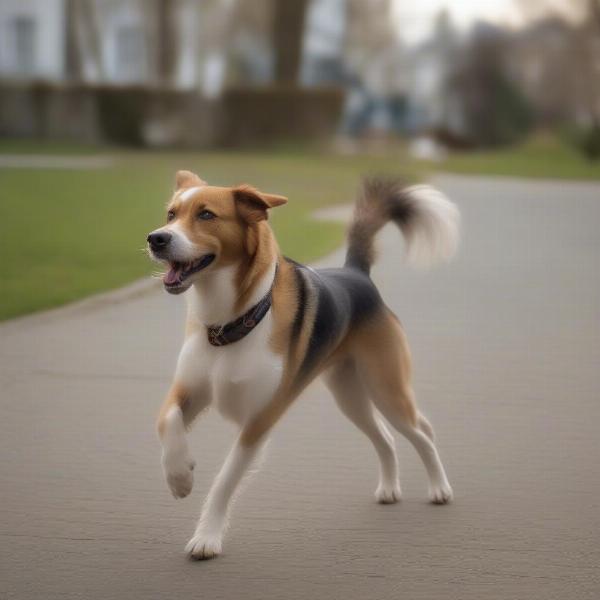The term “hot dog sign” might conjure up images of a tasty treat, but in the canine world, it refers to a specific symptom of back pain. Recognizing this “hot dog sign” in your dog can be crucial for early diagnosis and treatment of potential underlying issues. This article will explore what the hot dog sign is, what it indicates, and the steps you should take if you notice it in your furry friend.
What is the “Hot Dog Sign”?
The “hot dog sign” describes a characteristic posture dogs adopt when experiencing back pain. Their back arches upwards, much like the curve of a hot dog, often accompanied by stiff, extended legs. The dog may also be reluctant to move or may cry out when touched in the affected area. This posture is a natural reaction to discomfort, as the dog attempts to minimize pressure and pain in its spine. Observing this sign is a significant indicator that your dog requires veterinary attention.
 Dog with stiff legs and hesitant to move
Dog with stiff legs and hesitant to move
Why Does My Dog Display the “Hot Dog Sign”?
Several factors can contribute to a dog exhibiting the “hot dog sign,” including intervertebral disc disease (IVDD), muscle strains, arthritis, or even spinal trauma. IVDD, a common condition particularly in certain breeds like Dachshunds, occurs when the cushioning discs between vertebrae degenerate or herniate, putting pressure on the spinal cord. Muscle strains can result from overexertion, sudden movements, or falls, while arthritis causes inflammation and pain in the joints, including those of the spine. Trauma, such as being hit by a car, can also lead to spinal injuries and the subsequent “hot dog sign” posture. It’s important to hot dog signs as a serious indicator of a problem and seek professional advice.
What Should I Do if I See the “Hot Dog Sign”?
If you notice your dog exhibiting the “hot dog sign,” it’s crucial to seek veterinary care immediately. Do not attempt to treat your dog at home or manipulate their spine yourself. Prompt veterinary diagnosis is essential to determine the underlying cause of the pain and develop an appropriate treatment plan. This may include pain medication, anti-inflammatory drugs, physical therapy, or in severe cases, surgery. Early intervention can significantly improve the chances of a full recovery and prevent further complications. Remember, your dog’s health depends on your vigilance and timely action. Don’t ignore the hot dogs sign – it’s a clear signal that your furry friend needs help.
Conclusion
The “hot dog sign” is a clear indicator of back pain in dogs and should never be ignored. While it might seem like a simple postural change, it can signify a range of underlying conditions requiring veterinary attention. By recognizing this sign and seeking prompt professional help, you can play a vital role in ensuring your dog’s well-being and a quicker recovery. Don’t hesitate to contact your veterinarian if you observe the “hot dog sign” – your dog will thank you for it. Never underestimate the importance of hot dog asl in ensuring your pet’s comfort and health. It could be a sign of a more serious underlying issue.
FAQ
- What does the “hot dog sign” look like? The dog’s back arches upwards, resembling a hot dog, with stiff, extended legs.
- Is the “hot dog sign” serious? Yes, it indicates back pain and requires immediate veterinary attention.
- What causes the “hot dog sign”? Conditions like IVDD, muscle strains, arthritis, or spinal trauma.
- Should I treat my dog at home? No, always consult a veterinarian for diagnosis and treatment.
- Can my dog recover from this? Yes, with proper veterinary care and treatment, most dogs recover well.
- What breeds are prone to IVDD? Dachshunds, Beagles, Basset Hounds and other long-bodied breeds.
- How can I prevent back problems in my dog? Maintaining a healthy weight, regular exercise, and avoiding strenuous activities can help.
ILM Dog is your trusted partner for expert dog care advice and information. We offer a comprehensive range of resources on dog breeds, health, training, nutrition, grooming, and much more. Our team of experienced professionals is dedicated to helping you provide the best possible care for your canine companion. Whether you’re looking for help with choosing the right breed or need advice on senior dog care, dog keeps gulping or need advice on the best products and accessories, ILM Dog is here to support you. Contact us today at [email protected] or +44 20-3965-8624 to learn more about how we can assist you.